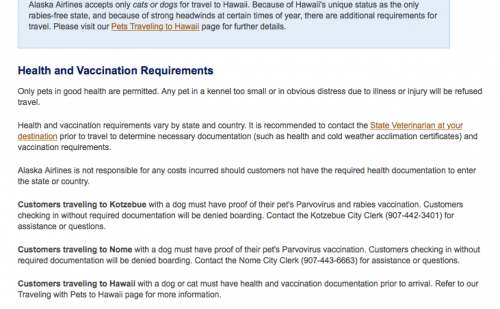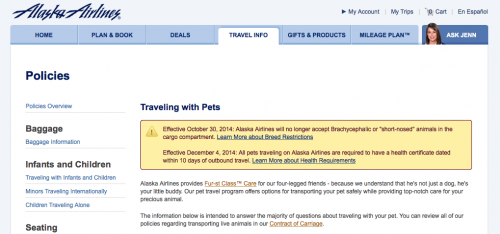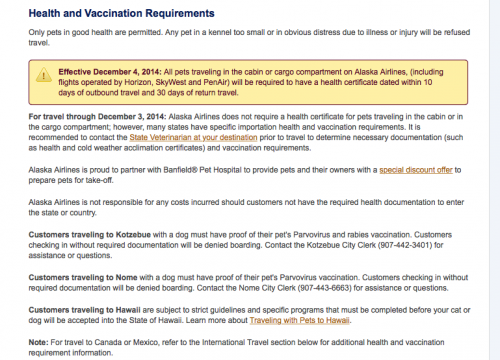Alaska Airlines now requiring a health certificate for all pets
In what is, I hope, a move that no other U.S. airline will follow, Alaska Airlines has decided to require a health certificate for pets flying in-cabin (Alaska also requires a health certificate for crated pets checked as baggage/cargo, but that’s normal policy for U.S. airlines transporting animals). The new policy applies to flights on December 4, 2014 and following, and states that “All pets traveling in the cabin or cargo compartment on Alaska Airlines, (including flights operated by Horizon, SkyWest and PenAir) will be required to have a health certificate dated within 10 days of outbound travel and 30 days of return travel.”
My first inkling that this was in the works was an e-mail from reader Gery, who wrote to me three weeks ago saying that he’d been repeatedly instructed by an Alaska Air rep to get a health certificate for his in-cabin dog, and wasn’t that odd? Indeed it is: When we first started flying with Chloe in 2009, a handful of U.S. airlines required health certificates for in-cabin pets, but over the succeeding years, all of them dropped the requirement. As of April 2013, I wrote that “only Hawaiian Airlines” still required “a health certificate for in-cabin pets, and then only for travel outside the state.”
When Gery wrote to me, Alaska’s page about pet travel still looked like this:

Alaska’s former hands-off approach
But now it looks like this:

New Alaska policy
And this:

Just in case you were feebly hoping it didn’t apply to in-cabin pets
On the one hand, I appreciate their saving me a phone call by making it clear that the new rule applies to pets traveling in-cabin as well as pets stowed in the cargo area. On the other hand, I don’t really see the point of extending the requirement to in-cabin pets, who don’t face the same kind of stress that pets traveling in the cargo area have to handle.
On the third hand, it’s not a change that affects me, since I don’t fly Alaska, but I worry that other airlines will follow Alaska’s lead. I remember all too vividly how vexing it was to have to remember to plan a timely vet visit (within 10 days of travel) and ensure that the certificate covers the return trip (in the case of long vacations, that means visiting another vet at your destination). Each vet visit typically costs about $50, as Gery discovered and as I recall from the bad old days.
Can you, you know, just…well…not do it? In my experience, no. Back when United required a health certificate for in-cabin pets, I faithfully got one for each trip because the ticketing agent routinely asked to see it when we checked ourselves and Chloe onto our flights. My sympathies to you, Alaska flyers, and I hope that other U.S. airlines will resist the urge to fall into line behind Alaska. Here’s Dog Jaunt’s health certificate requirement chart, now updated, alas, to reflect Alaska’s new policy.




